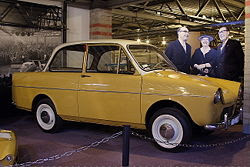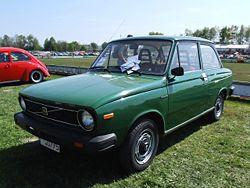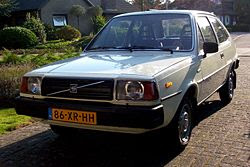DAFs, anyone?
02.29.2008
Hands up, class! How many of you have heard of, let alone ridden in, a DAF? That many? Well, I’m not really surprised; we Full Metal Autoss are peculiar folk, aren’t we, especially in our pursuit of wheeled happiness. And by that I don’t necessarily mean elegance, performance, or glamour. In the long history of my early automotive obsessions–along with the various Ford Anglias, Renault Dauphines, and Citroen DSs already chronicled elsewhere in these pages–the eccentric products of Van Doorne’s Automobiel Fabriek of Eindhoven, Holland, known as DAFs, rank high; but whatever their virtues, they were no paradigms of panache. Never mind; I loved ‘em. DAFs were original, quirky, and not without a certain style. They were also pioneers in automotive history, being the first cars to feature the Variomatic transmission, an early form of continuously variable transmission (CVT). CVTs, of course, are super-refined automatics that change seamlessly through an infinite number of gear ratios. They’re standard equipment now on cars from such mainstream manufacturers as Nissan, VW-Audi, and Chrysler, but back in the ‘50s they were unique to DAF, and quite a revelation to people only just recovering from the deprivations of war, who were used to suffering behind the wheel as in life. The little Dutch car, with just a stick shift for selecting forward or reverse, made driving easy. It was like having an enclosed golf cart that could bustle along at a serious 70 m.p.h.-–not with any great energy, mind you, at least not at first. The original production DAF, the 600, which came out in 1958, had (as its name suggests) a 600-c.c. engine, and barely enough oats to get out of its own way.

1958 DAF 600
But the cars improved over time. Indeed, they were so successful at first, especially among older people not inclined to wrestle with stiff and unwieldy stick shifts, that new models followed rapidly, each with a larger engine than its predecessor: the 750; the 44; in 1968, the 55, with the 1108-cc 50 hp engine of the Renault 8; the downright peppy 55 and 66 Marathon models, which introduced a line of sporty DAFs with more horses (60) for the masses, especially the ever-elusive youth market; and, for the family, there was the Combi station wagon. The 66 handled better then previous DAFs, thanks to an improved leaf-sprung axle design. It even started winning road rallies, and acquired a reputation for reliability and character, if not for blistering acceleration.
Then, as so often happens in the car industry, just when the product was really improving, the public turned its back. The mid-‘70s were pretty desperate years for the little Dutch cars, which were failing to attract much of a clientele beyond the senior-citizen market, Dutch loyalists, and younger oddballs. As one of the latter, I was sufficiently tempted around about this time (I liked the crisp lines and unpretentious uniqueness of the things) to take one of the more sophisticated models, the 66, for a test drive through the Jura mountains of France. I was smitten. It drove smoothly and well, even on twisting mountain roads in the slippery slush of early spring. Just the thing, I reckoned, and never mind that I was then an out-of-pocket, semi-employed would-be writer, and that I was living in an attic in my mother’s house. I gathered together sufficient coins left over from the English lessons I was giving to the locals and put down a deposit on a pine-green beauty at the local Volvo dealer–yes, Volvo. By then (’76) DAF as a car company had ceased to exist. Presto change-o, the Swedes had marched in and saved the day by extinguishing the firm. (It still exists as a truck manufacturer). All DAF grill badges were switched for the Volvo diagonal arrow, and automatically the customer base expanded, for those who’d been embarrassed to drive a DAF were quite willing to be known as Volvo owners.
Alas, I wasn’t to be one of them. Further negotiations at the dealership determined that my income, such as it was, would fail to keep pace with car-payment demands. My car was repossessed before it was even sold. So, after recouping my deposit, I reluctantly left DAFs and Volvos behind and resumed teaching my English classes. Anyway, soon enough thereafter my allegiance, ever fickle, shifted back to Citroens.
 But a seed had been planted, both worldwide and at home. The 66 and its successor, the 343, sold well over a million copies over the next ten or so years, and one of them was to my mother, who for 22 years drove her Volvo-DAF happily all over Europe, until age and infirmity intervened and the car, and she, went to their respective unknowns.
But a seed had been planted, both worldwide and at home. The 66 and its successor, the 343, sold well over a million copies over the next ten or so years, and one of them was to my mother, who for 22 years drove her Volvo-DAF happily all over Europe, until age and infirmity intervened and the car, and she, went to their respective unknowns.






